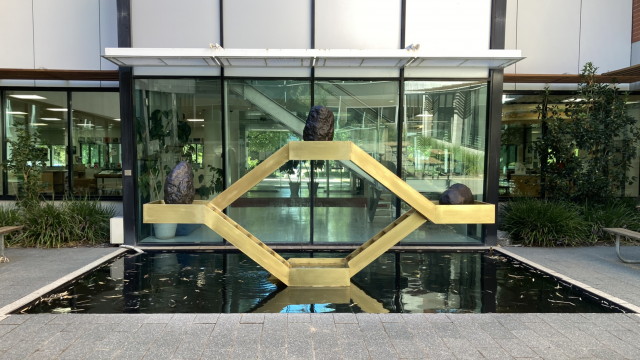ANU welcomes new sculpture by Kensuke Todo: Utsuroi 移ろい (transience)

“If sculpture is the rock it is also the space between the rock and a man, and the communication and contemplation between.” – Isamu Noguchi

Kensuke Todo, Utsuroi 移ろい (transience), 2025, design sketch. Courtesy of the artist
The Australian National University is proud to announce the installation of a newly commissioned sculpture by acclaimed artist Kensuke Todo. Todo’s brass and bronze construction now glimmers in place above the pond in the Hancock Library courtyard. Echoing the library’s internal staircase and the three monumental rocks that adorn the courtyard’s garden, Utsuroi 移ろい (transience) acts as a meeting point between humankind and the natural world.
The sculpture’s position in this vital intersection recalls both the ANU’s motto, naturum primum cognoscere rerum – “first to know the nature of things”, and the Japanese architectural concept of ma. Ma refers to the interval between incidents or things, the gaps, spaces and differences, filled with meaning, alive in human imagination. The alignment of these two references is apt for the Japanese born artist whose interest in the differing experiences of space in Japanese and Western culture propelled him across the sea to study at the ANU School of Art first on exchange in 1999, and then to complete a MA (Visual Arts) in Sculpture in 2004.

Kensuke Todo, Utsuroi 移ろい (transience), 2025 (installation view, ANU Hancock Library courtyard), brass, cast bronze, stainless steel. Australian National University Art Collection, commissioned 2025.
Since graduating Todo has established himself as a local artist of significant renown with strong ties to the ANU and the Drill Hall Gallery, presenting a solo exhibition in 2014. He is known for his architecturally inspired sculptures that recast the urban environment as a vessel for the human condition. The staggered gradient of the staircase in Utsuroi symbolises the teleological concept of progress imagined as a continual interchange between nature and technology. Its’ diamond formation, mirrored in the water below, recalls the double-helix structure of DNA, connecting the formal elements of architecture to the building blocks of life.
Three rocks sit at the junctures between the staircases in Utsuroi. Their rough surfaces, cast in bronze, quietly contrast the clean lines and smooth brass of the main structure. Water spills over the stairs, pooling around the rocks, dripping into the pond below. Its continual motion echoes the constant stream of knowledge as we move through life. As the water flows over Utsuroi its materials will gradually tarnish, reflecting its own passage through time and paying homage to the courtyard’s previous sculpture, Hezzie Carleton’s Ingress Egress, which was destroyed by the hailstorm of 2020.
Todo recognised the Hancock Library as a site of knowledge and learning, its courtyard a place of contemplation and respite. He hopes his considered, site-specific sculpture will “contribute to the site for students and visitors for their inspiration and enjoyment.”
The original article was published on the DRILL HALL GALLERY.